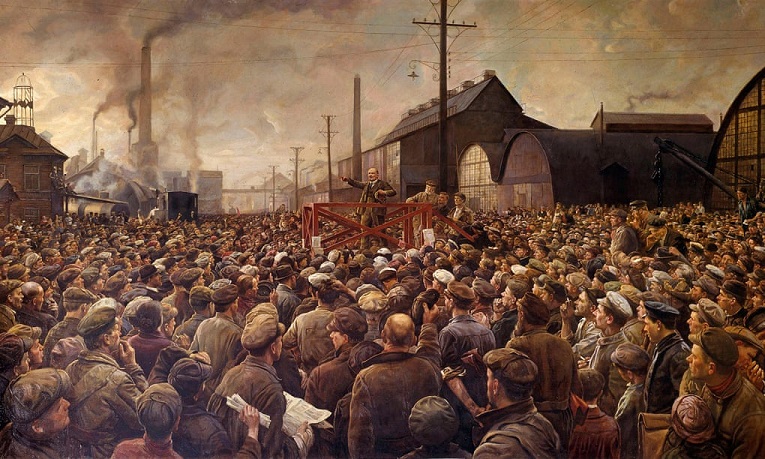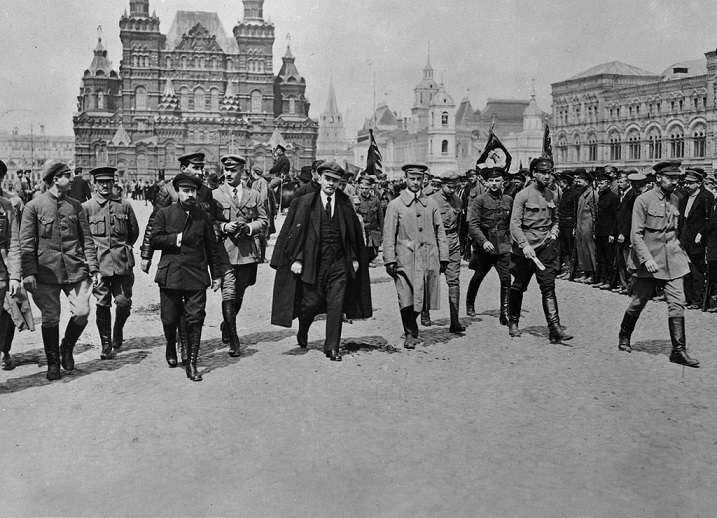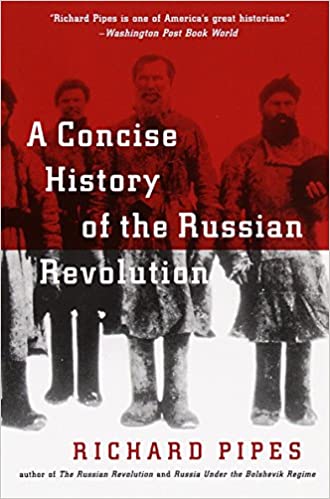Review: A Concise History of the Russian Revolution

Richard Pipes’ primer covers the waning years of tsarism in Russia and the deposition of Nicholas II, the ensuing Bolshevik Revolution and Lenin’s rise to power, and the re-constituted Russian state under Lenin. The book’s contents conclude shortly after Lenin’s death in 1924, aged 54. Naturally, the main “characters” here are Vladimir Lenin, the theoretical basis of Bolshevism, and the longstanding traditions of Russian society — the canvas on which Leninism was superimposed. Toward the end we do get some brief remarks on Stalin, including the historical responsibility due Lenin for the deeds of his successor, but this serves as more of an entrée that’s left for later Russian chronologies to flesh out.
One of the more controversial issues surrounding this era concerns the connection between Marxism and Leninism as implemented under the Bolshevik regime. Here I can report the author surprised me. Given his Reaganite credentials, not to mention his family’s status as Polish refugees following Germany’s invasion at the onset of the Second World War, I expected him to hew rather closely to the views of Martin Malia and other staunchly anti-communist historians who insist that Lenin- and Stalin-esque regimes are more or less a natural consequence of Marxist-socialist philosophy. Instead, Pipes argues quite persuasively that the events of the October Revolution and the regime that took the place of tsarism were a unique function of the cult of personality around Lenin combined with the legacy of patrimonialism and other structural factors native to Russian society.
In effect, Pipes shows that the Bolsheviks were not very good Marxists, despite rhetorical protestations to the contrary from the leading acts. A key feature of Marxism is the transfer of power from the bourgeoisie (capitalist ruling class) to the proletariat (the unwealthy subjects that comprise the working class). Yet at seemingly every opportunity, the Bolsheviks altogether ignored the needs of the working class, instead prioritizing the needs of the Party and the retention and accretion of power at all costs. If the interests of Lenin & Co. happened to coincide with those of the proletariat underclass, that was all the better, but where the two were in conflict, the former saw fit to hang the latter out to dry.
“If Marxism means anything, it means two propositions: that as capitalist society matures it is doomed to collapse from inner contradictions, and that this collapse (“revolution”) is effected by industrial labor (“the proletariat”). A regime motivated by Marxist theory would at a minimum adhere to these two principles…[the Bolsheviks] distorted Marxism in every conceivable way.”
Some historians and philosophers go further and argue that we shouldn’t refer to the Bolshevik Revolution as a ‘revolution’ at all since it was more akin to a putsch or a coup by an extreme ideological minority. In contrast to the National Socialist Party in Germany, which attained influence by means of democratic consent thanks to right-leaning factions with which Hitler’s overtures primarily resonated, the Bolsheviks yielded only slim representation in government until their proximity to power improved through the use of force and subterfuge and they began stacking the deck in their favor. The peasant class, which made up some 80 percent of the Russian population at the time, was for the most part passively ambivalent about tsarism and harbored a deep mistrust of the Bolshevik intelligentsia behind the seizure of power that set Russia on a new path.
“The so-called “October Revolution” was a classic coup d’état. The preparations for it were so clandestine that when Kamenev disclosed in a newspaper interview a week before the event was to take place, that the party intended to seize power, Lenin declared him a traitor and demanded his expulsion. Genuine revolutions, of course, are not scheduled and cannot be betrayed.”
“[The philosopher Nicholas] Berdiaev, who viewed the Revolution primarily in spiritual terms, denied that Russia even had a Revolution: “All of the past is repeating itself and acts only behind new masks.”
In practice — from the perspective of the evidence from the regimes with which they’re associated, the recorded words, deeds, and policies of its leadership, and the documented effects on Russian society — Leninism-Stalinism or Bolshevism shared precious little in common with the philosophy it purported to embody, and is best viewed historically as a perversion of Marxist thought.
“Indisputably, the theories underpinning bolshevism, notably those of Karl Marx, were of Western origin. But it is equally indisputable that Bolshevik practices were indigenous, for nowhere in the West has Marxism led to the totalitarian excesses of Leninism-Stalinism…A cause that yields different results in differences circumstances can hardly serve as a sufficient explanation.
Marxism had libertarian as well as authoritarian strains, and which of the two prevailed depended on a country’s political culture…Marx’s notion of a “dictatorship of the proletariat” was sufficiently vague to be filled with the content nearest at hand, which in Russia was the historic legacy of patrimonialism. It was the grafting of Marxist ideology onto the sturdy stem of Russia’s patrimonial heritage that produced totalitarianism. Totalitarianism cannot be explained solely with reference to either Marxist doctrine or Russian history; it was the fruit of their union.
In view of these facts, ideology has to be treated as a subsidiary factor—an inspiration and a mode of thinking of the new ruling class, perhaps, but not a set of principles that either determined its actions or explains them to posterity. As a rule, the less one knows about the actual course of the Russian revolution, the more inclined one is to attribute a dominant influence to Marxist ideas.”
In the end, Leninism conformed strikingly closely to its predecessor, tsarism. This suggests that Lenin and his fellow travelers borrowed from familiar themes and practices employed by tsarist autocracy as well as gradually created the conditions to stretch them further. In doing so, they supplanted one form of totalitarianism with another, and in several respects eclipsed the repressive nature of earlier regimes.
“Tsarist patrimonialism rested on four pillars: (1) autocracy—that is, personal rule unconstrained by either constitution or representative bodies; (2) the autocrat’s ownership of the country’s resources, which is to say, the virtual absence of private property; (3) the autocrat’s right to demand unlimited services from his subjects, resulting in the lack of either collective or individual rights; and (4) state control of information. A comparison of tsarist rule at its zenith with the Communist regime as it looked by the time of Lenin’s death reveals unmistakable affinities.”
Finally, the relationship of Leninism to Stalinism, including how best to apportion responsibility for Stalin’s stint as potentate and the carnage that ensued, is among the most hotly debated issues by historians and philosophers alike. I think it’s fair to say from the available evidence that a substantial portion of the blame for Stalin can be placed at Lenin’s feet. After all, Stalin was Lenin’s protégé, with the latter virtually handing the former a “free and clear” dictatorship on a silver platter.
Their governance style, moreover, differed more in terms of degree than substance or practices. Both were uncompromising despots, but Stalin’s outgroup was wider. Where Lenin tried to court ethnic minorities during his rule (even if his doing so amounted to insincere gestures layered in pretext), Stalin outright anathematized those same groups and incorporated them into his systematic persecution of political dissidents.
“That in the last months of his active life Lenin developed doubts about Stalin and came close to breaking off personal relations with him should not obscure the fact that until that moment he had done everything in his power to promote Stalin’s ascendancy…Stalin was the only person who belonged to all three of the ruling organs of the Central Committee: the Politburo, the Orgburo, and the Secretariat… Lenin ensured that the man who controlled the central party apparatus controlled the Party and through it the state. And that man was Stalin…There is no indication that he ever saw Stalin as a traitor to his brand of communism.
Beyond the strong personal links binding the two men, Stalin was a true Leninist in that he faithfully followed his patron’s political philosophy and practices. Every ingredient of what has come to be known as Stalinism saved one—murdering fellow Communists—he had learned from Lenin, and that includes the two actions for which he is most severely condemned: collectivization and mass terror. Stalin’s megalomania, his vindictiveness, his morbid paranoia, and other odious personal qualities should not obscure the fact that this ideology and modus operandi were Lenin’s. A man of meager education, he had no other model or source of ideas.”
Whereas the belief that German history would have taken the same course sans Hitler is far from assured, the case for Russia leaving a fundamentally different mark on world events without Stalin at the helm is less straightforward, to say the least. Had Lenin lived longer, we have almost every reason to believe that another two or three decades in power would have produced outcomes not unlike the history we have now. Lenin, after all, was the mastermind behind the Soviet Union and laid the foundations for the escalating inhumanity and cruelty Stalin later brought to fruition.
Note: This review is mirrored over at Goodreads and at Amazon.
Further reading:
- The Day That Shook the World
- Does the Russian Revolution have any relevance today?
- October by China Miéville review – a brilliant retelling of the Russian Revolution
- What If the Russian Revolution Had Never Happened?
- Top 10 books about the Russian Revolution
Feature image credit: Leemage/Corbis via Getty Images




Comments